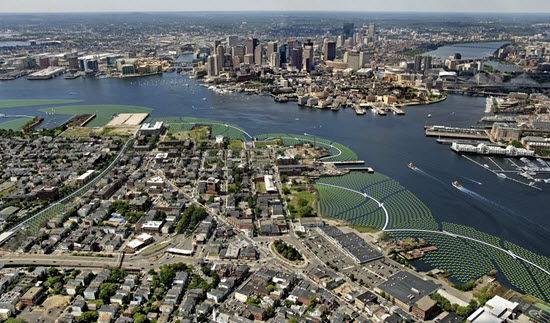A sustainable, climate-change-resilient floating landscape infrastructure took the top prize of the American Society of Civil Engineer’s latest Innovation Contest.
The winner, Emerald Tutu, provides a floating waterfront infrastructure that provides a city with an inhabitable waterfront amenity while mitigating the effects of climate change. “The contest is a springboard for forward-looking infrastructure ideas and aims to identify cutting-edge ideas from civil engineers, including students, educators, practitioners, and project managers,” according to an ASCE news release.
Another concept, “Smart Walls: Telescopic Structural Walls for Flood Protection,” also addressed climate resiliency. Smart Walls are deployable walls that are hidden in the ground and extend telescopically when needed to stop floodwaters.
The winner in the Best Student Submission category: “Rapid Restoration of Deteriorated Pre-stressed Concrete Bridges Using Mechanically Fastened Fiber Reinforced Polymer,” addressed deteriorated pre-stressed concrete bridge superstructure. It proposed a method to extend the useful life of infrastructure at low cost.
The Emerald Tutu from Very Flat on Vimeo.
Related Stories
| Sep 1, 2011
Project Aims to Automate Code Compliance Assessment
FIATECH, a consortium of owners from the industrial, power, and retail markets that build large structures, launched a project this year to validate the use of automation technology for code compliance assessment, and to accelerate the regulatory approval process using building models. Long-term objectives include the development of an extensive, open-source rule set library that is approved by industry and regulatory bodies for use by technology developers and code officials.
| Sep 1, 2011
EPA Says Additional Lead Paint Cleaning Rules Not Necessary
The EPA has concluded that current Lead: Renovation, Repair, and Painting Program (LRRP) cleaning requirements and lead-safe work regulations are sufficient to protect the public from lead dust hazards. “Our members have been instrumental in contacting legislators to detail the detrimental impact of the current LRRP," says Richard Walker, American Architectural Manufacturers Association’s president and CEO. “This collective industry voice has prompted the EPA to make the responsible decision to refrain from adding further, unnecessary costs to homeowners under the current economic climate."http://www.aamanet.org/news/1/10/0/all/603/aama-commends-its-members-congress-for-vacating-lrrp-clearance-rule
| Aug 11, 2010
Best AEC Firms of 2011/12
Later this year, we will launch Best AEC Firms 2012. We’re looking for firms that create truly positive workplaces for their AEC professionals and support staff. Keep an eye on this page for entry information. +







